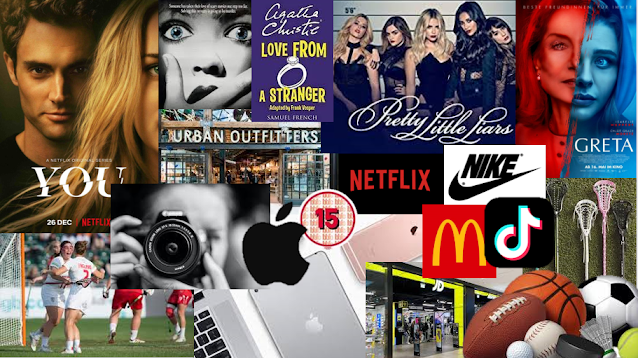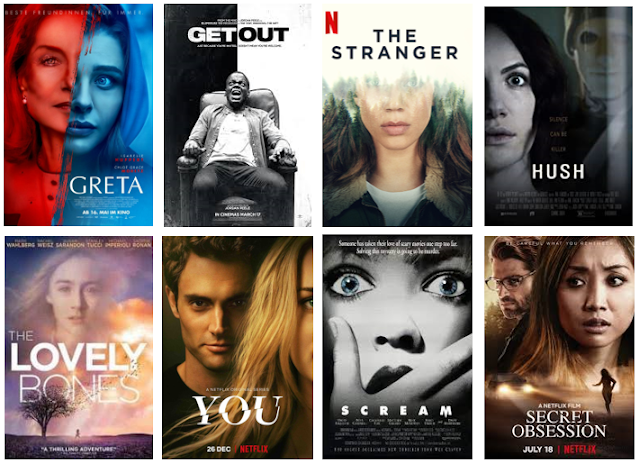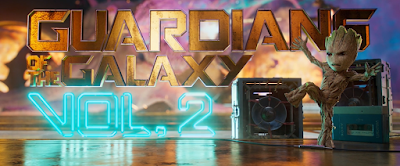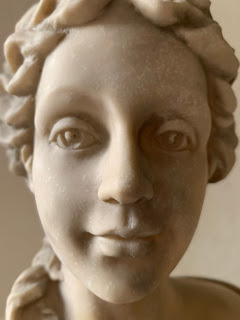Thursday, 26 November 2020
Friday, 20 November 2020
PLANNING: MY TARGET AUDIENCE
I needed to acknowledge who my target audience was going to be for my film and how to appeal to this group of people. I had to research age, gender, ethnicity and social class as well as popular genres and themes that featured in films that my target audience would watch.
1. Who is my primary target audience?
Young British males and females aged 15-25 who enjoy watching movies with thrill and suspense. We set this age range as teenagers and young adults are most likely to watch horror films and enjoy them rather than older generations. We may attract a wider female audience due to our female dominated cast.
2. What kind of films and television are they likely to prefer?
They are likely to enjoy thrilling television series and horror films that have gripping and realistic narratives as our film opening focuses more on real-life events with psychopaths and stalkers rather than a supernatural element. After doing some research, I discovered that the series 'You' is the kind of show that suits my target audience. It follows the narrative of Joe Goldberg, a bookstore manager in New York, who upon meeting Guinevere Beck, an aspiring writer, becomes infatuated with her. He feeds his toxic obsession using social media and other technology to track her presence and remove obstacles to their romance. As well as this, films such as 'Greta' and 'Secret Obsession' would have similar I think the audience of this series will enjoy our film too because we also aim to include the themes of obsession and realism in our film opening.
3. What platforms do they choose to watch films and where are they likely to see information about films?
Due to our younger target audience, they are likely to watch films on streaming platforms they can access from their phones such as Netflix and Amazon Prime. They would most likely find information about film through various social media sites, for example, Instagram and YouTube. Therefore, we will put lots of emphasis on social media when we are marketing our film as this will be the most effective way of engaging our audience.
4. What brands do they prefer?
 |
| Audience Profile |
5. What makes my film stand out from the competition?
Out film includes very realistic concepts that are effective in heightening the emotion for the audience as they can immerse themselves into the storyline and picture themselves in the same situation as the protagonist. We have also decided to challenge the stereotype of having a male predator to make our film stand out from the competition and not seem so cliché. Instead, we have chosen a female stalker which means our camera will not have the 'male gaze' that many films in Hollywood have, according to Laura Mulvey in 'Visual Pleasure and Narrative Cinema'.
6. Why should my audience watch my film?
It includes many popular features of a horror/thriller film as well as elements of psychological thrillers and contains a strong sense of realism which helps to intensify the action happening on screen and make the audience emulate the feelings of the actresses. It also includes a female lead and female dominated cast which promotes female power and feminism in the film industry.
Thursday, 19 November 2020
Monday, 16 November 2020
RESEARCH: AUDIENCE QUESTIONNAIRE
Some of the questions I asked were their age, gender and where they would prefer to view a trailer. I wanted to research the preferences of my target audience so I could work out what would please them most and make them want to watch my film.
The questions I intend to ask are as follows:
What age are you?
- 20 and under
- 21 and over
What gender are you?
- Male
- Female
- Prefer not to say
- Other
What genre of film do you prefer?
- Action
- Thriller
- Horror
- Romcom
- Comedy
- Drama
- Literacy adaptation
- Historical
- Sci-Fi
- Documentary
- Mystery
Do you tend to watch the trailer before deciding whether to watch a film?
- Yes
- No
- Sometimes
What platforms do you use to find out about films?
- Cinema
- Social Media
- Website
- Television
Are you influenced by any of the following?
- Reviews
- Recommendations
- Social Media
- Interviews
- Trailers
Do you like any of these trailers?
- If yes, why?
Do you like any of these posters?
- If yes, why?
PLANNING: CHARACTERS AND SOCIAL GROUPS
I used Mark Dixon's Media Theory for A Level to research stereotypes and discovered that they are universally deployed by the media. Stuart Hall states the 4 reasons why stereotypes are used by the media are as follows:
- To help audiences understand characters. Stereotypes act as a visual shortcut for the audience as they can instantly decode a character through the use of their body language, costume etc.
- To help audiences build character relatability. Audience empathy, sympathy and antipathy are achieved quicker when stereotypes are used so it emotionally connects the audience faster.
- To signpost audiences. Stereotypes help audiences gain a sense of the potential direction of the story. For example, the princess will find love, the hero will defeat evil etc.
- To reinforce genre expectation. All genres contain stock characters and audience's may be attracted to a movie due to these characters.
On the other hand, stereotyping can also be deemed as negative and dangerous. This is because it can create 'groups' who are identified through negative features and their 'otherness', together with the implication that the negative traits are 'natural' qualities. Examples of this are the stereotype that black men are naturally lawless or that blondes are dumb. This leads to what Stuart Hall calls 'power circularity', that is, the groups with power get to create the stereotypes and exclude other groups from the elite list.
 |
| 'When They See Us' and 'Legally Blonde' Examples of when these negative traits have been used in film |
We analysed the different social groups and stereotypes that we wanted to include in our product so that they were recognisable to audiences. I used Pinterest to find various pictures that represented these social groups and created various boards so we could clearly see the contrasting styles and emulate them in our film opening. The social groups we researched consisted of stalkers and sporty school girls.
By researching these stereotypes, we were able to conclude that things associated with stalkers were cameras and photos as well as dark lighting and so when capturing the stalker in our film, we will make sure to use low-lit lighting and create lots of shadows to emphasise the eerie feeling and mystery.
Our protagonist's main characteristic that we wanted to focus on was sports. We found the best ways to reinforce this would be through her clothing. Therefore, we will make sure that we choose our costumes wisely to fit the stereotype and will dress our actress in sportswear including clothing by well-known sports brands such as Nike.
Thursday, 22 October 2020
RESEARCH: SCOOPIT!
I created my own Scoop.It account (here) so I could research film openings to help brainstorm ideas for my own project. I aimed to look at film openings from thriller and horror films to match the genre of film I wanted to create with my group. We were not as keen to include the supernatural element in our production and so most of our inspiration came from films that revolve around the concept of psychopaths and murderers rather than ghosts and monsters.
RESEARCH: TITLE SEQUENCES
Thor Ragnarok (2017)
- Production Company - Marvel Studios
- Distribution Company - Walt Disney Studios Motion Pictures
- Director - Taika Waititi
- Writers - Eric Pearson, Craig Kyle and Christopher L. Yost
- Producer - Kevin Feige, p.g.a
- Executive Producers - Louis D'esposito, Victoria Alonso and Brad Winderbaum
- Executive Producers - Thommas M Hammel, Stan Lee
- Co Producer - David J. Grant
- Based on - Mavel Comics by Stan Lee, Larry Lieber and Jack Kirby
- Director of Photography - Javier Aguirresarobe
- Production Designers - Dan Hennah and Ra Vincent
- Editors - Joel Negron and Zene Baker
- Costume Designer - Mayes C. Rubeo
- Visual Effects Supervisor - Jake Morrison
- Visual Effects Producer - Cyndi Ochs
- Music - Mark Mothersbaugh
- Music Supervisor - Dave Jordan
- Casting - Sarah Halley Finn
- Chris Hemsworth, Tom Hiddleston, Cate Blanchett, Idris Elba, Jeff Goldblum, Tessa Thompson, Karl Urban, Mark Ruffalo and Anthony Hopkins
- Production Company - Walt Disney Pictures Pixar Animation Studios
- Distribution Company - Walt Disney Studios Motion Pictures
- Director - Andrew Stanton
- Co Director - Angus Maclane
- Producer - Lindsey Collins, p.g.a
- Executive Producer - John Lasseter
- Associate Producer - Bob Roath
- Writer - Andrew Stanton
- Screenplay - Andrew Stanton and Victoria Strouse
- Music - Thomas Newman
- Story Supervisor - Max Brace
- Film Editor - Axel Geddes
- Production Designer - Steve Pilcher
- Supervising Technical Director - John Halstead
- Production Manager - Becky Neiman-Cobb
- Supervising Animators - David Devan and Michael Stocker
- Directors of Photography - Jeremy Lasky and Ian Megibben
- Character Art Director - Jason Deamer
- Sets Art Director - Don Shank
- Character Supervisor - Jeremie Talbot
- Sets Supervisor - Colin Hayes Thompson
- Effects Supervisor - Chris J Chapman
- Rendering Supervisor - Humera Yasmin Khan
- New Technology Integration Supervisor - David Ryu
- Global Technology and Simulation Supervisor - Patrick Coleman
- Crowds & Additional Animation Supervisor - Paul Mendoza
- Crowds Technical Supervisor - Paul Kanyuk
- Sounds Designer - Tim Nielsen
- Casting - Kevin Reher and Natalie Lyon
- Ellen DeGeneres, Albert Brooks, Ed O'Neill, Kaitlin Olson and Hayden Rolence
Friday, 16 October 2020
DIGITAL STORYTELLING
I watched an informative video where Frank Ash, the creative consultant from the BBC talked about digital storytelling - how to connect with an audience emotionally. This can be done by creating a storyline that they can relate to as well as maximising the sense of anticipation and suspense throughout the film.
With this in mind, when planning my own production, I will devise a top line (one elegant sentence which sums up the film opening) and focus on the big question (what will happen next?).
I used the information from the video and turned it into a comic strip using ComicLife:
Friday, 9 October 2020
RESEARCH: DISTRIBUTION COLLAGE
I watched a presentation on the FDA website by Kezia Williams, head of theatrical distribution at Pathe. She talked about how distributors work to create a successful new marketing campaign for each film, on the film distributors' association site. It was also explained by Chris Besseling, Director of Marketing at Pathe, that distributors market a film's USP (Unique Selling Point) such as its star cast, its provenance, its awards and good reviews to bring positive attention to the film.
The film I decided to research was 'The Lion King'. This popular live action film was released on July 19th 2019 and was a remake of the original that came out June 15th 1994. The storyline follows the adventure of the young lion Simba, the heir of his father Mufasa. Simba's wicked uncle plots to usurp Mufasa's throne by luring father into a stampede of wildebeests. Simba manages to escape and only Mufasa is killed. Simba returns as an adult to take back his homeland from Scar with the help of his friends Timon and Pumbaa.
I investigated the different aspects of a marketing campaign and film distribution for this film. This consisted of film posters; the film website; film trailers; social medias such as Facebook; Twitter and Instagram as well as news articles; interviews; award ceremonies and cross promotion.
 |
| Press Conference on July 10th in Beverly Hills |
The film had plenty of promotional partnerships such as:
- Dole - which put sticker promotions for the movie on its fruit and made a series of themed recipes available coupled with tips on healthy eating.
- McDonald's - which offered customers that bought Happy Meals exclusive movie toys. Each toy connected with the others so customers could collect them and recreate scenes from the movie. They also ran TV spots to promote those Happy Meals
- Pandora - offered a line of jewellery inspired by the movie that was supported by in-store promotions and TV spots.
- Google - which included The Lion King as one of the three audiobooks read by Kristen Bell accessible exclusively through Google Home Mini.
- ASOS- which released a collection of clothing inspired by the iconic sights, colours and charactes from the film.
- Luminess - which offered a collection of movie-inspired make-up in collaboration with Sir John.
Cross-Promotion

Wednesday, 7 October 2020
PRODUCTION PRACTICE: MONTAGE/TABLETOP SEQUENCE
"WHOLE WORLD IN A TABLE TOP"
Our brief was to create a title sequence using only a table top and props with a small part of live action at the end of it, using a given soundtrack.
For research, in class we watched Delicatessen and To Kill a Mockingbird which both use table top sequences. The camera gets placed in a birds-eye-view shot and pans over a cluster of overlapping props to suggest a certain narrative.
Preesha, Charlotte and I worked together to produce a title sequence that revolved around the story of a mother of two (Olivia Blake) who has gone missing and an investigation is taking place.
In session 1, we set up our table top, placing a black cloth over the table to use as a background. We arranged our props - which consisted of lots of newspapers; a briefcase; an investigation board; a passport; lots of dollar bills and a screwdriver. We used fake blood and smeared it onto the dollar bills and coated the end of the screwdriver in it to infer the idea that she had been murdered. We organised our props and guided the camera in a specific order so that the end shot would be of the main newspaper article with a printed picture of Olivia's face which was effective as we then placed the screwdriver down on top of it to heighten drama and tension. I also marked my hands in fake blood and as the camera was panning over the investigation board, I placed a pin into it.

We then uploaded our footage to iMovie where we added our soundtrack - 'Moonlight Sonata' by Beethoven which added to the creepy ambiance we were aiming for. We also added in credits and used a fade in and out effect to add mystery.
Sunday, 27 September 2020
CONTINUITY EXCERCISE
Brief account of the making of our continuity exercise and problems we faced.
Our task was to make a short clip with continuity editing in order to put into practice, the camera angle techniques we had learnt. In our groups, we had to create a storyboard, assign roles and edit our clips together at the end on the iMacs. Our continuity exercise is set on the show of 'Who Wants to be a Millionaire?' on the final question with Tom as the host and Charlotte acting as the guest.
We also had to deal with ambient noise of other groups and so we had the studio cleared so their voices would not interfere with our recording.
Thursday, 17 September 2020
ON THE SET
Brief account of learning how to handle a camera, terminology to use on set and good practice in editing.
Camera and Tripod: In a group, we passed the camera around so we could practice how to handle it, insert the memory card and place it on the tripod. When passing the camera from one person to another, you should say 'yours' and 'mine' to minimise the risk of it being dropped. When using the tripod, you use the spirit level to make sure the camera is level and secure. I learnt how to adjust the focus of the camera, which is done by turning the dial up and down as well as how to zoom in which is done by twisting the lens.
White Balance (WB) is the process of removing unrealistic colour casts, so that objects which appear white in person are rendered white in the photo. It allows the camera to acknowledge what the colour white look likes (the colour temperature) and therefore display all the other colours correctly resulting in a more realistic effect. To adjust this, you select 'WB' on the camera and it will display the different colour tones that are used in different lights.
180 Degree Rule: This is a cinematography guideline that states that two people in a scene should maintain the same left/right relationship to each other. There is an invisible axis that connects the two characters and if the camera 'crosses the line', the shot becomes what is referred to as a reverse shot.
On Set: I learnt about film terminology whilst on set. Once the camera is in focus, the director shouts "Standby" to alert everyone filming is about to start. Once they are ready, they reply with "Standing by". Once the director has said "rolling", everyone on set must stay quiet. Actors wait for the word "action" before they start moving and getting on with the scene.
Following this, at the end of the filming session, the director will say "strike the kit" which indicates to the film crew, it is time to pack away equipment, take the batteries out of the cameras and put them on charge and ensure that the footage is uploaded.
Good Practice in Editing: The software we are using are Final Cut Pro and iMovie which are downloaded on the iMacs in the media studio. When uploaded footage, the shots should be saved into a folder. These folders are called bins and the unedited footage from cameras are called rushes.
Monday, 15 June 2020
RESEARCH: ART OF THE TITLE - GUARDIANS OF THE GALAXY VOL.2
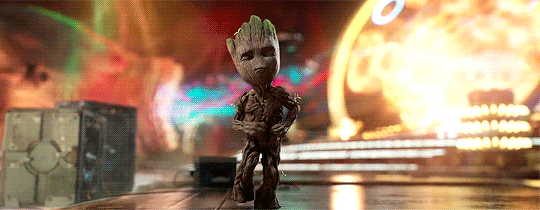
Sunday, 14 June 2020
RESEARCH: ART OF THE TITLE - SHERLOCK
Furthermore, throughout the title sequence, the creators use a low opacity to allow the fast movement of images and clips to overlap each other and fade in and out, giving the title sequence a mysterious effect because the blur of images makes it is hard to focus on one thing and analyse it. Equally, it also creates a manic and busy feel as everything is happening at once, making the audience feel frantic and overwhelmed. I also found this technique effective because it is almost symbolic of the main character 'Sherlock Holmes'. This is because in the second shot, we are shown is a close-up shot of his eyes which is followed by the overlapping images. Therefore, it is as if the audience are entering Sherlock's brain and seeing the world from his point of view and all the images are various thoughts and visions in his head. This gives us an insight into his character and we can appreciate his remarkable intellect as he can deal with all these overwhelming thoughts and pieces of information, store it and then use irrelevant and small details to solve crimes.
Press here for audio codes of Sherlock Title Sequence
Tuesday, 9 June 2020
RESEARCH: ART OF THE TITLE - MINDHUNTER

I chose to analyse Mindhunter because I took interest to its success in creating a dramatic build up of tension and I aim to follow similar steps when I work with my group to devise my own film opening.


Sunday, 7 June 2020
FILM SOUND TECHNIQUES AND THEORY
I studied the different terminology used to identify sound in films through the presentation Film Sound Techniques and Theory I learnt that you can use various techniques to influence the audience to interpret a scene in a certain way.
Monday, 18 May 2020
PRODUCTION PRACTICE: MONTAGE/TABLETOP SEQUENCE
"WHOLE WORLD IN A TABLE TOP"
Our brief was to create a title sequence using only a table top and props with a small part of live action at the end of it, using a given soundtrack.
For research, in class we watched Delicatessen and To Kill a Mockingbird which both use table top sequences. The camera gets placed in a birds-eye-view shot and pans over a cluster of overlapping props to suggest a certain narrative.
Preesha, Charlotte and I worked together to produce a title sequence that revolved around the story of a mother of two (Olivia Blake) who has gone missing and an investigation is taking place.
In session 1, we set up our table top, placing a black cloth over the table to use as a background. We arranged our props - which consisted of lots of newspapers; a briefcase; an investigation board; a passport; lots of dollar bills and a screwdriver. We used fake blood and smeared it onto the dollar bills and coated the end of the screwdriver in it to infer the idea that she had been murdered. We organised our props and guided the camera in a specific order so that the end shot would be of the main newspaper article with a printed picture of Olivia's face which was effective as we then placed the screwdriver down on top of it to heighten drama and tension. I also marked my hands in fake blood and as the camera was panning over the investigation board, I placed a pin into it.

We then uploaded our footage to iMovie where we added our soundtrack - 'Moonlight Sonata' by Beethoven which added to the creepy ambiance we were aiming for. We also added in credits and used a fade in and out effect to add mystery.
"WHOLE WORLD IN A TABLE TOP"
Our brief was to create a title sequence using only a table top and props with a small part of live action at the end of it, using a given soundtrack.
For research, in class we watched Delicatessen and To Kill a Mockingbird which both use table top sequences. The camera gets placed in a birds-eye-view shot and pans over a cluster of overlapping props to suggest a certain narrative.
Preesha, Charlotte and I worked together to produce a title sequence that revolved around the story of a mother of two (Olivia Blake) who has gone missing and an investigation is taking place.
In session 1, we set up our table top, placing a black cloth over the table to use as a background. We arranged our props - which consisted of lots of newspapers; a briefcase; an investigation board; a passport; lots of dollar bills and a screwdriver. We used fake blood and smeared it onto the dollar bills and coated the end of the screwdriver in it to infer the idea that she had been murdered. We organised our props and guided the camera in a specific order so that the end shot would be of the main newspaper article with a printed picture of Olivia's face which was effective as we then placed the screwdriver down on top of it to heighten drama and tension. I also marked my hands in fake blood and as the camera was panning over the investigation board, I placed a pin into it.

We then uploaded our footage to iMovie where we added our soundtrack - 'Moonlight Sonata' by Beethoven which added to the creepy ambiance we were aiming for. We also added in credits and used a fade in and out effect to add mystery.
ON THE SET
Brief account of learning how to handle a camera, terminology to use on set and good practice in editing.
Camera and Tripod: In a group, we passed the camera around so we could practice how to handle it, insert the memory card and place it on the tripod. When passing the camera from one person to another, you should say 'yours' and 'mine' to minimise the risk of it being dropped. When using the tripod, you use the spirit level to make sure the camera is level and secure. I learnt how to adjust the focus of the camera, which is done by turning the dial up and down as well as how to zoom in which is done by twisting the lens.
White Balance (WB) is the process of removing unrealistic colour casts, so that objects which appear white in person are rendered white in the photo. It allows the camera to acknowledge what the colour white look likes (the colour temperature) and therefore display all the other colours correctly resulting in a more realistic effect. To adjust this, you select 'WB' on the camera and it will display the different colour tones that are used in different lights.
180 Degree Rule: This is a cinematography guideline that states that two people in a scene should maintain the same left/right relationship to each other. There is an invisible axis that connects the two characters and if the camera 'crosses the line', the shot becomes what is referred to as a reverse shot.
On Set: I learnt about film terminology whilst on set. Once the camera is in focus, the director shouts "Standby" to alert everyone filming is about to start. Once they are ready, they reply with "Standing by". Once the director has said "rolling", everyone on set must stay quiet. Actors wait for the word "action" before they start moving and getting on with the scene.
Following this, at the end of the filming session, the director will say "strike the kit" which indicates to the film crew, it is time to pack away equipment, take the batteries out of the cameras and put them on charge and ensure that the footage is uploaded.
Good Practice in Editing: The software we are using are Final Cut Pro and iMovie which are downloaded on the iMacs in the media studio. When uploaded footage, the shots should be saved into a folder. These folders are called bins and the unedited footage from cameras are called rushes.


